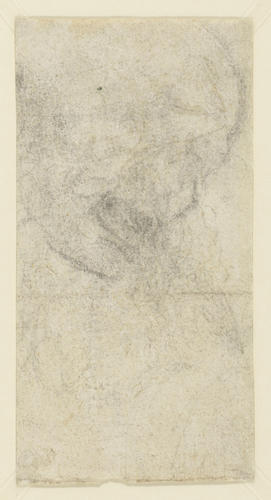-
1 of 253523 objects
The bust of an old man (R); A study for St Jerome (V) c. 1482
Pen and ink (R); Charcoal (V) | 13.0 x 6.7 cm (sheet of paper) | RCIN 912441

Leonardo da Vinci (1452-1519)
The bust of an old man (R); A study for St Jerome (V) c. 1482

Leonardo da Vinci (1452-1519)
The bust of an old man (R); A study for St Jerome (V) c. 1482


-
On the recto, the head and shoulders of an old man in left profile wearing an extravagant hat. In his features and dress he resembles the older man standing before the staircase in the background of Leonardo’s Adoration of the Magi (Uffizi), but is not a study for that figure, and seems to be a casual sketch from the imagination, of a type made by Leonardo throughout his life. Clark and Pedretti (Drawings of Leonardo da Vinci at Windsor Castle, 1968) saw it as ‘an early drawing, c.1480 or earlier’, but it does not have the crude vigour of Leonardo’s drawings of the 1470s; instead, it has a decorative softness that places it in the first half of the 1480s.
On the reverse of the sheet is a study of a head, executed in charcoal that has suffered from rubbing, which has distorted the drawing and compromised its apparent quality. The drawing was briefly catalogued by Clark and Pedretti (cit.) as a ‘Rough sketch of the outline of a cheek and eye of a head turned very slightly to the right, traces of hair hanging down, mouth open as in an expression of agony’, without further discussion. The ‘traces of hair’ are in fact pen-lines showing through from the recto – the head as drawn is bald. And rather than ‘turned very slightly’, the head is dramatically tipped and twisted in all three axes. Rapid lines define the profiles of the forehead, the left brow, the sharp cheekbone, the jaw and the pointed chin. The mouth gapes open and the right eye is illegible; the left eye is small, and though its gaze cannot be determined, even in this broad sketch it seems to be ringed with fatigue. A patch of shading to the left of the sheet shows that the light falls from the right, fully onto the face.
This drawing seems to be a study for the head of the saint in Leonardo’s St Jerome (Vatican, Pinacoteca): there were to be small adjustments of proportion and elaborations of detail, but the correspondence with the painting is remarkably close. The St Jerome is not documented or mentioned in any early source, and has no early provenance. Most scholars now date its inception to the 1480s, but opinions range widely, from the late 1470s (in Leonardo’s first Florentine period) into the early 1490s. It is likely that Leonardo returned to the painting around 1510, refining the anatomical details in light of his dissections of that period (for which see RCIN 919000-919017).
The drawing on the verso is so rough that it is impossible to determine a date from its style alone, but it is reasonable to assume that recto and verso of the sheet were drawn around the same time, in the early 1480s. The panel of St Jerome is walnut, strong evidence for an origin in Milan (rather than typically Florentine poplar). Given the apparent date of this study, the most likely scenario is that the painting was begun upon Leonardo’s arrival in Milan, sometime after September 1481 (when he was last documented in Florence), and left unfinished when he was commissioned to paint the Virgin of the Rocks in April 1483.
See M. Clayton, ‘A head study for St Jerome’, in Leonardo: Arte come progetto. Studi di storia e critica d’arte in onore di Pietro C. Marani, Bologna 2022, pp. 25-29.
Provenance
Bequeathed to Francesco Melzi; from whose heirs purchased by Pompeo Leoni, c.1582-90; Thomas Howard, 14th Earl of Arundel, by 1630; Probably acquired by Charles II; Royal Collection by 1690
-
Creator(s)
Acquirer(s)
-
Medium and techniques
Pen and ink (R); Charcoal (V)
Measurements
13.0 x 6.7 cm (sheet of paper)
Category
Object type(s)